
Olene mendosa, the brown tussock moth or hairy tussock moth, is a species of moth in the family Erebidae. The species was first described by Jacob Hübner in 1823. It is found in India, Bangladesh, Sri Lanka, Indonesia, Taiwan, Thailand and Australia.

Cryptophlebia ombrodelta, the litchi fruit moth or macadamia nut borer, is a moth of the family Tortricidae. The species was first described by Oswald Bertram Lower in 1898. It is native to India, Sri Lanka, Nepal, Indonesia, China, Taiwan, Vietnam, Thailand, western Malaysia, New Guinea, the Philippines, Japan, Guam, the Caroline Islands, Australia and has been introduced to Hawaii.

Penicillaria jocosatrix, the mango shoot borer, is a moth of the family Euteliidae first described by Achille Guenée in 1852. It is found from southeast Asia to the Pacific. Records include Borneo, Guam, Hawaii, India, Sri Lanka, Thailand and in Australia, Western Australia, the Northern Territory and Queensland.

Herpetogramma licarsisalis, commonly known as the grass webworm or pale sod-webworm, is a species of moth in the family Crambidae.

Biston suppressaria, the tea looper, is a moth of the family Geometridae. It is found in China, India, Myanmar, Nepal, and Sri Lanka.

Adoxophyes fasciculana, the bell moth or orange tip moth, is a moth of the family Tortricidae. It was described by Francis Walker in 1866 from the Moluccas. It is also known from South Asia, Vietnam, Australia and the Pacific Islands. It is a polyphagous pest on several commercially important crops.
Archips micaceana is a moth of the family Tortricidae. It is found in China, Hong Kong, southern Vietnam, Burma, and northern Thailand. It is a minor pest of many agricultural crops.
Dudua charadraea is a moth of the family Tortricidae first described by Edward Meyrick in 1909. It is found in Thailand, Sri Lanka, Taiwan, western Java and western Sumatra.

Lobesia aeolopa is a moth of the family Tortricidae first described by Edward Meyrick in 1907. It is found in Vietnam, Thailand, India, Sri Lanka, Myanmar, Java, the Solomon Islands, Korea, Japan, Taiwan, São Tomé and Príncipe, Tanzania, South Africa, Réunion and Madagascar.

Statherotis discana, the litchi leafroller, is a moth of the family Tortricidae. It is found in Thailand, Taiwan, Japan, the Philippines, India, Java, the Solomon Islands, the Moluccas and New Guinea.

Bactra optanias is a species of moth of the family Tortricidae first described by Edward Meyrick in 1911. It is found in Papua New Guinea, Australia, New Zealand, Java, Tahiti, Sri Lanka, New Caledonia, the Caroline Islands, the southern Mariana Islands, Rapa Iti and Micronesia.
Strepsicrates rhothia is a species of moth of the family Tortricidae first described by Edward Meyrick in 1910. It is found in Taiwan, Sri Lanka, India, the Democratic Republic of the Congo, Ghana, Madagascar, Mauritius and South Africa.

Cnesteboda celligera is a species of moth of the family Tortricidae first described by Edward Meyrick in 1918. It is found in India, Sri Lanka, Vietnam, Taiwan, Malaysia and Indonesia.

Kunugia latipennis, the pine lappet moth, is a moth of the family Lasiocampidae. The species was first described by Francis Walker in 1855.

Thalassodes immissaria is a moth of the family Geometridae first described by Francis Walker in 1861. It is found in the Oriental tropics of China, India, Myanmar, Sri Lanka, Hong Kong, Japan, Borneo, Vietnam, Sumatra, Sulawesi and the Ryukyu Islands. The populations in Ryukyu were often classified as a subspecies - Thalassodes immissaria intaminataInoue, 1971. However, in 2005 this subspecies was upgraded to a distinct species, which can be distinguished from immissaria by careful examination of the male genitalia.
Thalassodes veraria, is a moth of the family Geometridae first described by Achille Guenée in 1858. It is found in Sri Lanka, Fiji, India, Java, Malaysia, New Guinea and Australia.

Chlumetia transversa, the mango shoot borer, is a moth of the family Euteliidae. The species was first described by Francis Walker in 1863. It is a widely distributed across Indo-Australian tropical countries far east to Solomon Islands.

Parasa bicolor, the green rice moth, is a moth of the family Limacodidae. The species was first described by Francis Walker in 1855. It is found in Sri Lanka, India, Nepal, Pakistan, Myanmar, Laos, Taiwan, Vietnam, Malaysia, Java, China and Taiwan.

Pammene critica, the redgram webber or leaf webber, is a moth of the family Tortricidae. The species was first described by Edward Meyrick in 1905. It is found in India and Sri Lanka.
Endothenia citharistis is a moth of the family Tortricidae first described by Edward Meyrick in 1909. It is found in India, Sri Lanka, Java and Myanmar.














